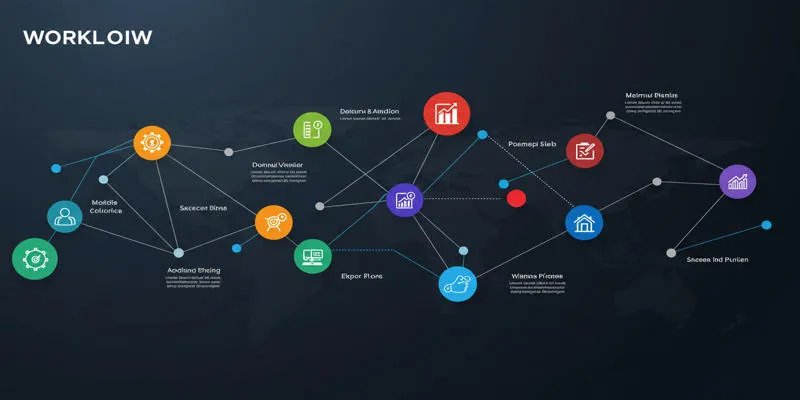Workflow management
The modern business landscape operates under an absolute requirement for optimal efficiency and productivity. Workflow management has risen to become a primary discipline that provides optimal methods for completing tasks. Organizations that correctly implement workflow management principles together with their definition will maximize operational performance while clearing process roadblocks to advance business goal attainment and improve collaboration within their teams.
What is Workflow Management? Defining the Core Concepts
 Workflow management defines procedures to automate and direct a series of business activities needed to execute operations throughout a process. Businesses study work movements across their organization to find improvement opportunities before implementing optimization methods. Workflow management establishes an efficient method that defines one logical path for tasks to progress continuously from beginning to completion.
Workflow management defines procedures to automate and direct a series of business activities needed to execute operations throughout a process. Businesses study work movements across their organization to find improvement opportunities before implementing optimization methods. Workflow management establishes an efficient method that defines one logical path for tasks to progress continuously from beginning to completion.
Workflow management contains essential components, which are:
- Workflow visualization demonstrates all process steps alongside their initial data points and results alongside decision points.
- The integration of technological systems streamlines monotonous operations, lowers human labor requirements, and boosts productivity levels.
- The process of sending suitable assignments to qualified personnel or teams depends on their expertise and work availability.
- The tracking system enables real-time observation of task advancement and reveals production slowdowns as well as delayed operations.
- The workflow improves constantly through the analysis of data and continuous feedback application.
Why is Workflow Management Important? The Benefits Unveiled
An effective workflow management system generates various advantages that benefit organizations of different scales.
- Automation through workflow management saves time and decreases effort; therefore, it boosts operational efficiency.
- Costs decrease when organizations optimize their workflows thus minimizing mistakes while cutting down operational expenses.
- The workflow management system improves team collaboration by enabling group members to share similar project objectives through improved communication channels.
- Real-time tracking tools allow managers to obtain instant visibility of task statuses, which enables them to solve emerging problems immediately.
- A workflow management system enables organizations to raise customer satisfaction through improved service speed and fewer errors, which results in enhanced product delivery.
- A properly defined process lets organizations expand their operations smoothly during periods of business growth.
Key Components of a Workflow Management System
A workflow management system consists of three main components: a workflow engine, form design capabilities, and a task monitoring interface.
- The Workflow Engine functions as the central component to execute tasks and direct operation sequences in workflow execution.
- Form Designer enables users to develop as well as modify data collection forms used for management purposes.
- Task Management Interface presents a platform to assign, monitor, and execute tasks through a user interface.
- The system contains tools thatgenerate reports as well as tools to study workflow performance metrics.
- System integration power refers to the ability to merge operations with CRR document systems.
Best Practices for Effective Workflow Management
For successful workflow management implementation, organizations need to plan their execution method thoroughly. The following list contains best practices to implement:
- You Should Make Your Workflow Management Initiative Objectives Crystal Clear by Defining Them Properly. Your organization needs to identify its target issues for resolution. You want to accomplish what improvements exactly?
- The initial step for workflow enhancement requires a full understanding of present operational procedures. Draw a representation of your current procedures to identify each action alongside its starting elements and final results alongside the choice-making stages.
- The process mapping phase enables you to detect operational points where process flow is slowed down and evaluate wasteful flows throughout the system. Identify work steps that need d reduction in processing time, produce errors, or force employees to perform time-consuming manual operations.
- Design optimized workflows that address the problems that appeared during analysis through optimization of bottleneck areas and inefficient processes. Let machines do repetitive jobs along with process improvement and cross-team working enhancements.
- Select an appropriate workflow management system that fulfills all your particular business needs. When choosing management systems, select options that fulfill all criteria, including features, scalability, ease of use, and necessary integration points.
- The Complete Implementation Should Avoid Attempting All Workflows During A Single Phase. Begin by managing essential workflows and build your workflow management implementation step by step throughout different periods.
- Employee Training Begins with Investing Proper Training Time to Create Knowledge About The New Workflows Together With Tools. Train all team members about their required roles and duties.
- Regular workflow performance checks must be combined with results measurement activities. Monitoring your system should include tracking cycle time performance, error rates, and customer satisfaction scores.
- The workflow improvement process needs continuous implementation. Smith rewrites work processes based on quantitative analysis and user evaluation data.
Workflow Management Tools: A Comparative Overview
Tool | Description | Key Features |
|---|---|---|
Kissflow | A low-code platform that allows businesses to create custom workflows and automate processes. | Visual workflow builder, form design, task management, reporting, integration with other systems. |
Process Street | A workflow management tool that focuses on creating and managing checklists and procedures. | Checklist management, task assignment, workflow automation, reporting, and integration with other systems. |
Trello | A popular project management tool that can also be used for basic workflow management. | Kanban boards, list management, task assignment, collaboration features, and integration with other systems. |
Asana | Another popular project management tool that offers workflow management features. | Task management, project tracking, collaboration features, reporting, and integration with other systems. |
Monday.com | A work operating system that allows teams to manage workflows, projects, and tasks visually and collaboratively. | Visual workflow builder, task management, project tracking, collaboration features, reporting, and integration with other systems. |
Nintex | A comprehensive workflow automation platform that offers a wide range of features for designing, automating, and managing complex workflows. | Visual workflow designer, form design, task management, document automation, integration with other systems. |
Challenges in Workflow Management and How to Overcome Them
 Workers adopt reluctance toward process changes when training and first-level information about new workflows are inadequate. Elaborate on the benefits of the new procedures and organize sufficient skill-building education.
Workers adopt reluctance toward process changes when training and first-level information about new workflows are inadequate. Elaborate on the benefits of the new procedures and organize sufficient skill-building education.
The workflow management initiative will fail because management does not fully commit to the program. The process starts with securing approval from the main stakeholders by presenting workflow management's potential advantages.
Confused workflows resulting from undefined processes cause a higher rate of errors and confusion. Your solution starts with dedicating time to draw and explain all processes in detail.
The selection of the wrong tools during workflow management can hinder successful implementation. Your requirement analysis must include a search for tools that adequately meet your existing needs.
Users of their business processes remain unaware of workflow effectiveness. A solution includes workflow performance tracking features that allow you to monitor operations.
The Future of Workflow Management
Workflow management will experience transformative developments due to the implementation of several main trends that will shape its future direction.
- Artificial Intelligence and Machine Learning technologies will significantly influence workflow management. They will automate work tasks, forecast project delays, and enhance process efficiency.
- Low-code/No-Code platforms simplify workflow creation and customization tasks by eliminating the need for staff to have elaborate coding abilities.
- Cloud-based workflow management solutions will gain popularity because they deliver accessible workflow environments coupled with flexible solutions and scalable capabilities to organizations.
- Workflow management systems will connect more frequently with IoT devices to perform automated process control using real-time data.
Conclusion
Today, workflow management exists as a fundamental managerial practice that helps organizations achieve higher levels of operational effectiveness, cost reduction, and better customer satisfaction results. Companies that adopt correct workflow management principles combined with a deep knowledge of its meaning will optimize their business operations to reach their strategic objectives. The achievement of workflow management success depends on implementing a full system that encompasses process identification, tool development, and performance tracking. Businesses that adopt workflow management methods will find both transformation and their complete potential release.
On this page
What is Workflow Management? Defining the Core Concepts Why is Workflow Management Important? The Benefits Unveiled Key Components of a Workflow Management System Best Practices for Effective Workflow Management Workflow Management Tools: A Comparative Overview Challenges in Workflow Management and How to Overcome Them The Future of Workflow Management ConclusionRelated Articles

Upgrade Your Streaming: 5 Chrome Extensions to Enhance Video Quality

Kanban vs. Scrum

7 of the Best Gmail Filters to Organize Your Inbox and Save Time

Which Are The 5 Best Pomodoro Timer Apps to Boost Your Productivity in 2025

Mute Any Video on Desktop in Seconds: The Ultimate Guide

Understanding Data Extraction and Automating It Efficiently

Lag-Free Screen Recording on Mac: 5 Tools You Need

The 8 Best Sitemap Generator Tools for 2025: An Ultimate Guide

Best Methods to Convert MKV to WAV Without Audio Quality Loss

Top AVI Converters for Mac: 7 Popular Tools to Try in 2025

Convert MXF Files Without Quality Loss: 5 Tools for Mac

 bobobk
bobobk